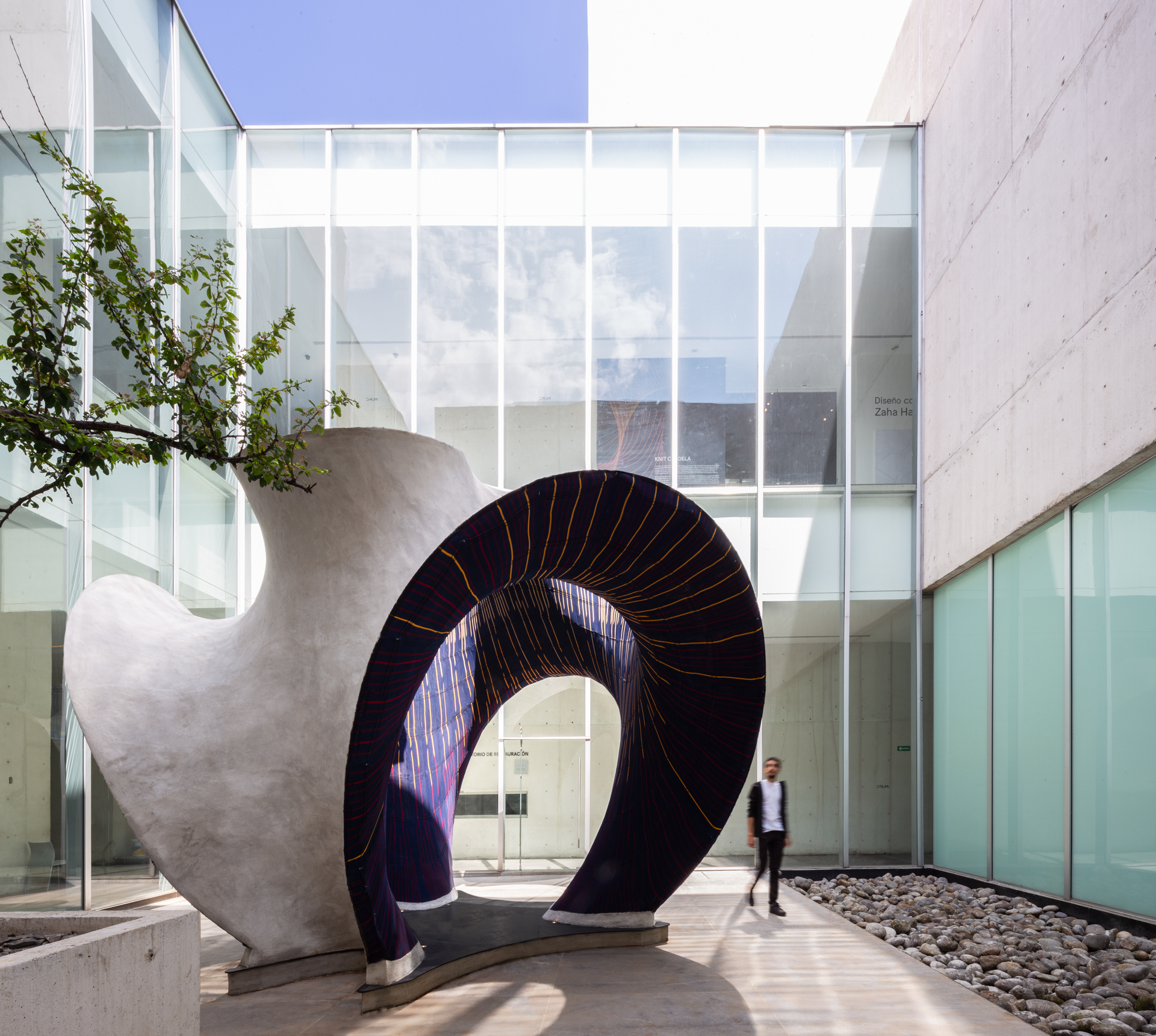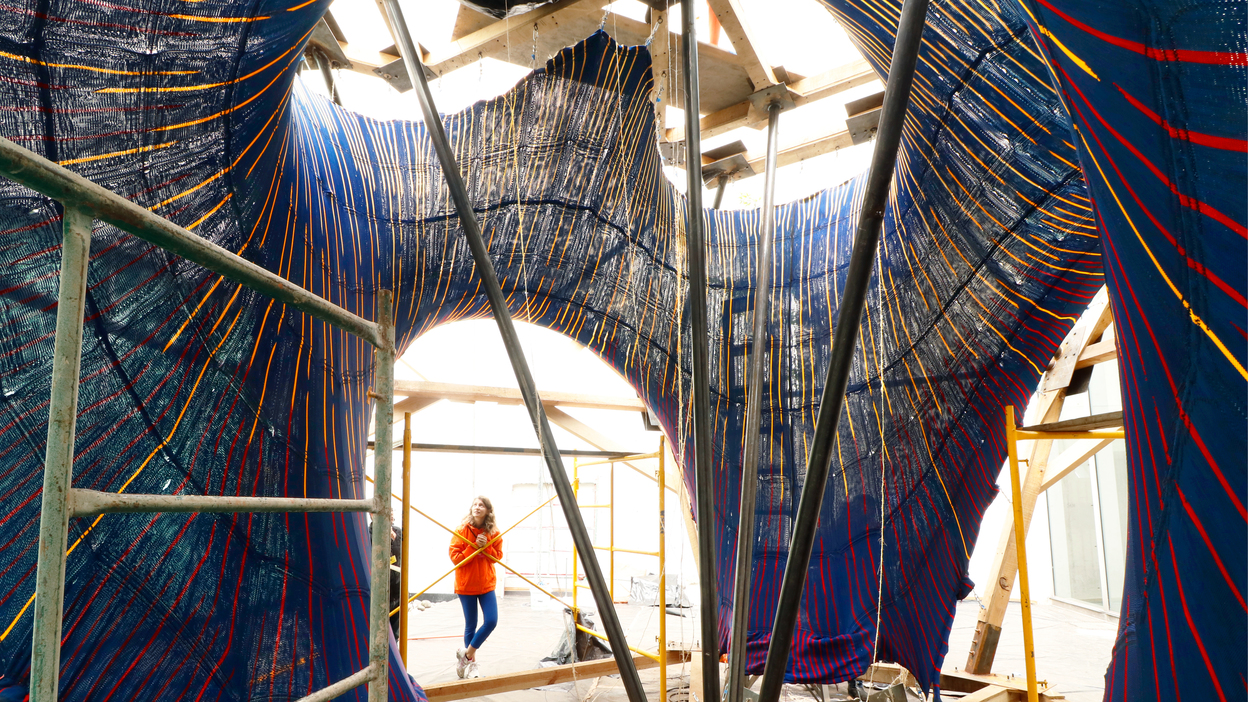KnitCandela
2018 Digital Fabrication KnitCrete Research sustainabilityKnitCandela is a thin, sinuous concrete shell built on an ultra-lightweight knitted formwork that was carried from Switzerland to Mexico in a suitcase. Built at the Museo Universitario Arte Contemporáneo (MUAC) in Mexico City as part of the first exhibition of Zaha Hadid Architects in Latin America (20.10.2018 – 03.03.2019), KnitCandela is a homage to the famous Spanish-Mexican shell builder Félix Candela (1910 – 1997). It reimagines his spectacular concrete shells through the introduction of novel computational design methods and the KnitCrete formwork technology.
The shell’s dynamic geometry is inspired by the fluid forms of the traditional and colourful dress of Jalisco, Mexico. The builders’ nickname for the project was ‘Sarape’, which is a scarf or poncho with a stripe pattern. The shape also pays homage to Candela’s famous restaurant at Xochimilco, a trope he repeated in several subsequent projects.
More Info
While Candela relied on combining hyperbolic paraboloid surfaces (or “hypars”) to produce reusable formworks and thus reduce construction waste, KnitCrete allows for the realisation of a much wider range of anticlastic geometries. With this cable-net and fabric formwork system, expressive, freeform concrete surfaces can now be constructed efficiently, without the need for complex moulds. KnitCandela’s thin, doubly-curved concrete shell with a surface area of almost 50 m2 and weighing more than 5 tonnes, was applied on a KnitCrete formwork of only 55 kg. The knitted fabric of the formwork system was brought to Mexico from Switzerland in a suitcase.
The 50 m2 of textile shuttering of the formwork for KnitCandela is made up of four long strips ranging from 15 m to 26 m in length. Each of the four pieces is a seamless, double-layered textile produced in one go. The two layers of the textile fulfill different tasks. The visible inside is an aesthetic surface that displays a colourful pattern and reveals traces of the supporting cable-net falsework system. The backside fulfils technical needs by including features for inserting, guiding and controlling the position of additional formwork elements.
The pockets created between the two layers as part of the spatial knitting process are inflated using standard modeling balloons. These inflated pockets become cavities in the cast concrete, forming a structurally efficient waffle shell without the need for a complex, wasteful formwork. On the technical side of the textile, the pockets have different knit densities to control the inflated shape and openings for the insertion of the balloons, such that differently sized cavities can be created with one standard balloon size.
The interplay between the soft, warm, colourful fabric on the inside of the shell and its hard, cold concrete exterior is visible from all viewing angles. The stripe pattern visualises the short rows typical of the knitting fabrication process and expresses the radial symmetry of the shape. The pattern along with the simultaneous visibility of the soft inside and the hard outside of the shell, enhances the spatial experience of the curvatures of the shape and the space it defines.
Collaboration
Designed and constructed by multiple teams in Europe and Mexico, the realisation of KnitCandela is the result of a collaborative effort that harnessed collective expertise in computational design, engineering and fabrication. The architectural design is the latest expression of the evolving search of the Computational Design Group of Zaha Hadid Architects (ZHCODE) for designs that utilise structural and constructional features to enhance the spatial experience of the user. For the realisation of this expression, the Block Research Group (BRG) of ETH Zurich introduced the KnitCrete formwork technology and developed the structural design and construction system. Architecture Extrapolated (R-Ex) managed the execution of the project on-site in Mexico City as part of its continued engagement in the digitisation of building trades in Mexico.
Fact Sheet
- Global dimensions shell: 5.8m x 5.8m x 4.1m
- Surface area of concrete: 47.5 m2
- Weight concrete: 5 tonnes
- Weight formwork: 30 kg (cable net) + 25 kg (knit)
- Total length yarn: 350 km (= approximately the width of Switzerland)
- Type of yarn: Polyester (PES)
- Total amount of loops: 14’660’028
- Knitting time: 36 hours
- Modelling balloons used: 1000
- Material cost formwork (excluding frame): CHF 2000
Publications
Popescu M., Rippmann M., Liew A., Reiter L., Flatt R.J., Van Mele T. and Block P. “Structural design, digital fabrication and construction of the cable-net and knitted formwork of the KnitCandela concrete shell”, Structures, 2020. In press
Popescu M., Rippmann M., Van Mele T. and Block P. “KnitCandela – Challenging the construction, logistics, waste and economy of concrete-shell formworks”, FABRICATE 2020, London, 2020 (April).
Credits
Short credits
BRG & ZHCODE with R-Ex
Block Research Group, ETH Zurich (BRG)
Zaha Hadid Architects Computation and Design Group (ZHCODE)
Architecture Extrapolated (R-Ex)
Full credits
Design
ZHCODE: Filippo Nassetti, David Reeves, Marko Margeta, Shajay Bhooshan, Patrik Schumacher
BRG: Mariana Popescu, Matthias Rippmann, Tom Van Mele, Philippe Block
KnitCrete technology
BRG: Mariana Popescu, Tom Van Mele, Philippe Block
Chair of Physical Chemistry of Building Materials, ETH Zurich: Lex Reiter, Robert Flatt
Fabrication and construction
BRG: Mariana Popescu, Matthias Rippmann, Alessandro Dell’Endice, Cristian Calvo Barentin, Nora Ravanidou
R-Ex: Alicia Nahmad Vazquez, Horacio Bibiano Vargas, Jose Manuel Diaz Sanchez, Asunción Zúñiga, Agustín Lozano Álvarez, Migue Juárez Antonio, Filiberto Juárez Antonio, Daniel Piña, Daniel Celin, Carlos Axel Pérez Cano, José Luis Naranjo Olivares, Everardo Hernández, Ramiro Tena.
Structural engineering
BRG: Andrew Liew, Tom Van Mele
Concrete development
Holcim Mexico: Jose Alfredo Rodriguez, Carlos Eduardo Juarez, Delia Peregrina Rizo
Site construction coordination
R-Ex: Alicia Nahmad Vazquez
Exhibition content, coordination, and curation
Zaha Hadid Exhibitions & Archives: Jillian Nishi, Margaratia Valova, Daria Zolotareva, Paz Bodelon, Elena Castaldi, Manon Janssens, Woody Yao
ZHCODE: Leo Bieling, Federico Borello, Filippo Nassetti, Marko Margeta, Henry David Louth, Shajay Bhooshan
BRG: Mariana Popescu, Matthias Rippmann, Noelle Paulson, Philippe Block
Sponsors
COMEX, ETH Zurich, NCCR Digital Fabrication, Zaha Hadid Architects, Steiger Participations SA, Holcim Mexico, Imerys Aluminates, Boston Consulting Group
Special thanks
Grupo Altiva, UNAM Arquitectura



